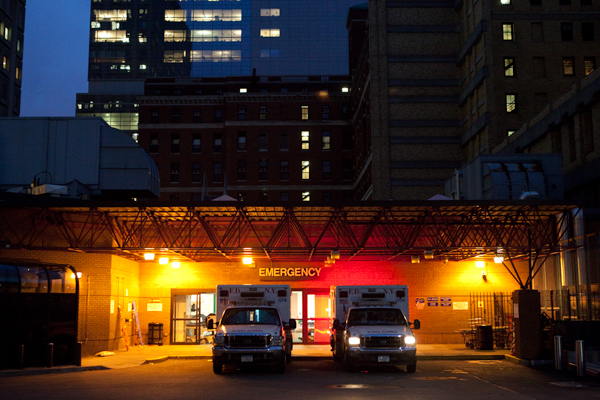
The ambulance bay at Bellevue Hospital.
When Danna Dennis worked as a home health aide on-and-off for 13 years, a typical daily commute to a client from her own home in Crown Heights was a grueling two hours, each way.
The ride — which often entailed traveling from one outer borough to another, often by bus — is one of the reasons Dennis eventually transitioned to work as a live-in aide, where she’d stay at a client’s home for several days at a time to avoid the daily back-and-forth.
“I did that specifically because of the commute,” said Dennis, who left the healthcare industry in January to become a community organizer with the transit advocacy group Riders Alliance. “Imagine working 12 hours a day, and then doing a two-hour commute each way.”
But Dennis’ prior struggles are not unusual for healthcare workers who rely on mass transit. They face the longest commute of any private-sector workers in the city, with a median travel time of 51.2 minutes, according to a report released earlier this year by the Center for an Urban Future.
Healthcare workers face a unique set of challenges when it comes to public transportation, the report found. They often work unconventional hours when subway and bus service are less frequent, and many live in outer-borough neighborhoods with fewer transit options. Many of their employers are now shifting to the outer boroughs, too: About two-thirds of the city’s healthcare jobs are located outside of Manhattan, the report found.
But for these workers, a reprieve may be in sight. In April, the MTA announced its Bus Action Plan, a blueprint to overhaul the city’s struggling bus system, including a re-evaluation of all 326 bus routes.
If done right, the overhaul could mean better commutes for healthcare employees, since many rely on buses to get around, experts say. CUF’s report found that there are more daily bus commuters in the healthcare sector than in any other industry, with 17.3 percent of healthcare workers getting to their jobs by bus.
“We are really encouraged by this,” Eli Dvorkin, managing editor at Center for an Urban Future, said of the MTA’s Bus Action Plan, which encompasses many of the same recommendations the Center’s own report made. “What we called for is exactly what this new transit commissioner is kind of putting forward.”
Those recommendations include creating more dedicated bus lanes, expanding the use of Transit Signal Priority to help buses move faster, and implementing things like all-door boarding and tap payment readers to speed up the boarding process.
Dvorkin also commended the MTA’s plan to re-evaluate all of its existing bus routes and potentially re-design them to be more efficient, or to remove closely-spaced, underutilized bus stops — what he sees as a necessary step to updating the bus network, which does not fully meet the city’s current needs.
“A lot of our bus routes are decades old at this point, and this city has changed so much,” he said. “We’re talking about bus routes that were laid out half a century ago.”
‘This is everybody’s issue’
The healthcare sector is city’s largest industry, with 500,000 employees and growing, according to CUF’s report. Since 1990, the number of healthcare workers here increased by 82 percent, with the fastest job growth taking place in boroughs outside Manhattan, the report found.
“This is half a million workers in New York City today,” Dvorkin said during a panel discussion held at TransitCenter in lower Manhattan on Wednesday night.
And to Dvorkin, these workers’ arduous commutes have a broader impact. With more healthcare jobs shifting to the outer boroughs, facilities that patients rely on are increasingly located in neighborhoods with fewer transit options.
More than a dozen hospitals and nursing homes in Brooklyn, for example, are at least eight blocks away from a subway stop, the report found. In the Bronx, more than 20 health facilities are eight blocks or more from a subway, and more than 25 in Queens are.
“This is everybody’s issue,” Dvorkin said. “It’s everybody that has to go visit a loved one in a hospital, in a long-term care facility. There’s issues for patients, there’s issues for their families, that’s everybody. That’s absolutely every single New Yorker.”
There are other potential consequences when healthcare workers have unreliable commutes. For an office worker, a delayed subway or slow bus might be inconvenient or even rage-inducing, but for those in the healthcare field, it could have a more serious effect.
“It’s not a job that you can call out,” Dennis, the former home health aide, said. “It’s not like I can’t show up and then my desk is just empty and I’ll figure it out the next day — there is still a patient that’s waiting on you, and their care does not go on hold. They still need their meds.”
“The needs of the industry are specific, and they’re pretty serious,” Dvorkin echoed. “Being late could actually be life threatening.”
What needs to be done
While Dvorkin and Dennis say they’re encouraged by the MTA’s Bus Action Plan, there are still hurdles to actually implementing the improvements it outlines.
“The MTA can’t do this alone. All of what’s in there is optimistic, but the real proof will be the implementation, and that remains to be seen,” Dvorkin said. “It’s going to require the full kind of buy-in and participation of city government, from the mayor on down, and we haven’t seen that in the last couple of years.”
The MTA will need the city’s involvement to do things like create new bus lanes and change traffic signals to benefit buses, according to City Councilman Mark Levine.
“We can’t exclusively blame the MTA, and we can’t only hold Andy Byford accountable for this, because the city does control the streets, and the traffic signals and the sidewalks, and traffic enforcement and broader policies that affect congestion,” Levine said during Wednesday’s panel. “Which actually, if you add that up, it’s probably most of what’s making life hell for bus riders.”
Levine said there’s often “political pushback” when dealing with changes to the city’s bus system, changes that often impact parking and traffic. He pointed to the rollout of Select Bus Service (SBS) routes, which have been met with criticism in the past.
“I can’t think of any proposed fix for the subways that wouldn’t poll at 99 percent approval. There’s no one who’s against fixing the signals, right? There’s no one who’s against renovating stations. But there are people who are against putting in more bus lanes. There are people who are against SBS,” Levine explained.
“It’s a very real challenge for fixing buses that we do not face with the subways.”
Dennis, the former home-health aide, thinks the most important thing the MTA can do in overhauling its buses is listen to the needs of healthcare workers and other frequent users, and really incorporate their input.
“They’re literally highlighting the fact that they’re going to take input from the community of riders, so I would like to see a lot of that be healthcare workers who are having these unconventional hours,” she said.
“They’re stranded in these transit deserts and they’re trying to get home at night.
I’d like to see them acknowledged.”
For more coverage of the MTA’s bus system, see City Limits’ series here.









2 thoughts on “MTA’s Bus Overhaul Could be Lifeline for Healthcare Workers, Who Face City’s Longest Commutes”
The buses here in the Bronx that run on a regular schedule are horrible. My co-worker has to take the BX19 and then the BX 35 to get home (only about 2 miles away). Sometimes it can take her up to 2 hours! The wintertime is the worse. If there is one little fender bender anywhere in the Bronx traffic is everywhere! This all needs to change.
2 hours! That’s awful. The local bus networks are a mess. Rumors are that the Bronx will receive an entirely new network with new routes where none now exist. Brooklyn to get new routes in southwest Brooklyn. Staten Island routes to be redesigned but low ridership and limited road capacity is the problem out there. Queens routes require the most study because Queens is so large.